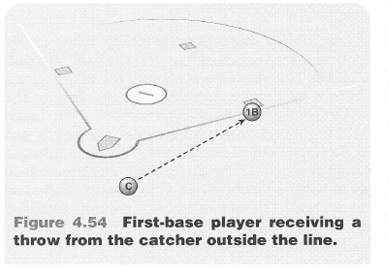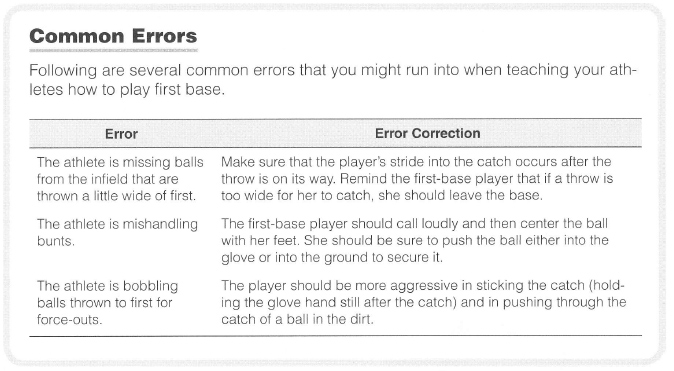|
Receiving Throws for Force-Outs by American Sport Education Program
If a ball is thrown short of the first-base player, she will need to adjust her stride to reach it. For long hops, the player does not step forward to catch the ball. Instead, she stays back and lets the ball come to her. For short hops, the player takes a long stride so that she can reach the ball before it bounces or a short stride close to the spot where the ball will bounce. In the latter case, she uses a wrist snap on the catch to control the catch because she is catching it right after it bounces. The key is get-ting the glove extremely close to and directly behind the bounce, and executing a forward snap of the glove pocket through the ball. If the throw happens to result in the dreaded medium hop, the best way to handle it is to take an aggressive stride and reach out in an attempt to make it a short hop. The last rule about receiving throws at first is that if the ball is thrown too wide for the first-base player to catch it, she should leave the base and go to the ball in an attempt to stop it. When a ground ball is hit hard to right field, the right fielder may be able to throw out the runner at first base. A right-handed first-base player again sprints to the bag, faces the right fielder and puts her throwing-hand foot against the bag. A left-handed first-base player needs to place the throwing-hand foot on the corner of the base closer to the right fielder, still inside the base path. Then, as the ball approaches, the first-base player stretches with the glove-hand foot to catch the ball. With no runners on, the catcher should back up the play because a throw wide to the foul line won't be safe for the first-base player to retrieve. To do that, the first-base player would need to cross over the base path, possibly colliding with the runner. Making Cutoffs to Home
For a cutoff, after the ball goes past the infield, the first- base player moves to the middle of the field about pitching distance from home plate, and the pitcher leaves the mound to back up the throw to home (see figure 4.53). The first-base player lines up with the outfielder who fields the ball to act as a cutoff and intercept the throw, if necessary Receiving a Dropped Third Strike
|
|
|





 The most common defense used to attempt to throw out runners at home and still be able to stop the ball and redirect it to another base has the first-base player as the cutoff. This defense is used only when the ball is hit deep enough to the outfield to warrant a throw home and when the first-base player has no immediate play at first on the hit.
The most common defense used to attempt to throw out runners at home and still be able to stop the ball and redirect it to another base has the first-base player as the cutoff. This defense is used only when the ball is hit deep enough to the outfield to warrant a throw home and when the first-base player has no immediate play at first on the hit. The rules of softball allow the runner to run to first if it isn't occupied and there are less than two outs when the catcher drops a third strike. If the batter reaches the base before the catcher can either tag her or throw the ball to first, the runner is considered safe. A dropped third strike will most likely go behind the catcher, so to help the catcher make a good throw, the first-base player should assume a position outside the foul line next to first base (see figure 4.54). By being in that position, the first-base player creates a clear path between the catcher and herself. Because the catcher is concerned with getting the ball and is not looking at the runner, the first-base player is responsible for recognizing the clear path, moving to it while still being able to touch first base and communicating calmly to the catcher her position by loudly saying "Outside." The catcher then knows the general area to throw to and that the fielder is there waiting.
The rules of softball allow the runner to run to first if it isn't occupied and there are less than two outs when the catcher drops a third strike. If the batter reaches the base before the catcher can either tag her or throw the ball to first, the runner is considered safe. A dropped third strike will most likely go behind the catcher, so to help the catcher make a good throw, the first-base player should assume a position outside the foul line next to first base (see figure 4.54). By being in that position, the first-base player creates a clear path between the catcher and herself. Because the catcher is concerned with getting the ball and is not looking at the runner, the first-base player is responsible for recognizing the clear path, moving to it while still being able to touch first base and communicating calmly to the catcher her position by loudly saying "Outside." The catcher then knows the general area to throw to and that the fielder is there waiting.



